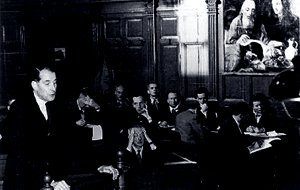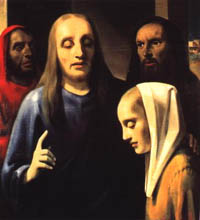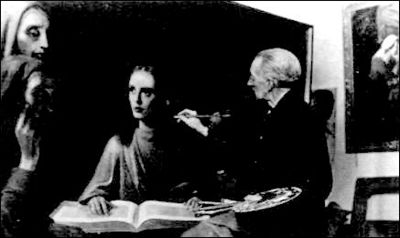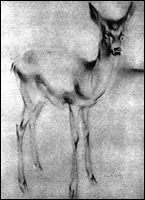
|
Present
Past
Subjects
Projects
Misc

|
THE DAY OF VAN MEEGEREN'S TRIAL
I wrote this story during the summer of 1987 in our house in Groningen. I remember that the weather was warm and that I worked at night, sitting at a table in the large room downstairs, banging away on an old typewriter. The tale was written for the catalogue of the exhibition 'A Priori Sculptuur' organized by Joseph Semah. The exhibition opened the fall of 1987 in Makkom, Amsterdam.
As our story begins we find ourselves sitting in the visitor's gallery of an old courtroom. The courtroom is crowded with neatly dressed men. Outside it is a clear crisp morning. Light is beginning to stream through the high windows, casting an outline of the narrow panes across the floor of the room, which remains cold. A mingled smell of clean clothes, polished wood, and cigars permeates the tight atmosphere.
In front of the room rises a tiered stage, in the center of which, around a slightly curved table, sit the five judges. Robed and looking very grave the judges are surrounded by the various officers and clerks of the court, some of whom are standing up with their arms crossed. The very effective seriousness of their stance is enhanced by the dark, traditional portraits decorating the ornate panelling at their backs. Although the pictures date from the golden age, the grouped and composed men in them appear to mirror and enlarge even more the scene in front of our eyes. Apart from the occasional creak of chairs and the scratch of pens on paper the room is still. Everyone is paying attention to the action before them, closely following the defendant's cross examination.

Illustration 1.
The courtroom in October or November 1947. Hans van Meegeren (the defendant) is seated with his head in his hands.
The defendant is in the dock and at this moment being questioned by one of the judges.
| |
| Q: | You still admit that you painted all these fakes? |
| A: | Yes, Mr. President |
| Q: | And also that you sold them, at a very high price? |
| A: | I had no alternative. If I sold them at a low price it would have been an indication, a priori, that they were false. |
| Q: | What brought you to continue on after you achieved the acceptance of your first forgery? You had proved a point, why did you carry on? |
| A: | I was carried away by the whole process. It was all so beautiful. I was no longer my own master. I lost my former will, I became powerless in the face of the great beauty of the situation. I was forced to continue. |
| Q: | That's all very well. But you also made a pleasant little profit. (This was said as a joke, without hostility.) |
| A: | (Ignoring the last question) I had to do it, Mr. President. In the past I've been so belittled by the critics that I could no longer exhibit my own work. I was systematically and maliciously destroyed by the critics, who don't know the first thing about painting. |
| Q: | Perhaps the financial side of the matter had some influence on your actions? |
| A: | It made little difference. The millions I earned from the later pieces were added to the millions I had earned already. I didn't do it for the money, which brought me nothing but trouble and unhappiness. |
| Q: | So you acted from no desire for financial gain? |
| A: | Only from a desire to make things of art, of beauty. I decided to carry on, not from a wish to make forgeries but to make the best use of the technique I had developed. I intend to continue using that technique. It's an excellent one. But I will never again age my paintings nor offer them as Old Masters. |
We are in Amsterdam. the date is October 29, 1947. Van Meegeren is on trial. He has been charged not with forgery but with collaborating with the Germans. His defense is based upon his claim that a picture that he supplied to Göring was not a national treasure, but a work from his own hand. The world is shocked. Many find his statement preposterous, impossible, but the evidence is supporting his claim.
 |
Illustration 2. Christ and the Adultress. 1941. This painting purportedly by Vermeer was bought by the Nazi propaganda chief Hermann Goering in 1943. |
The activities under investigation are fraudulent but no longer constitute an act of treason. Van Meegeren is even congratulated by the assembled experts for the quality of his work.
| |
| 1st Expert: | We must confess sir that we find your oeuvre excellent. |
| Defendant: | Thank you. |
| 2nd Expert: | It is not easy for us to admit we have been made fools of. |
| Defendant: | Of course not. |
| 1st Expert: | I'm afraid that your forgeries provided us with something we had all along hoped to find. |
| 2nd Expert: | Yes, you provided the plugs to fill the holes in our knowledge. Your work was carefully planned and executed to bridge an absence of material between two important periods of time, a number of years about which we have absolutely no information. In addition, for some of us, your work fulfilled a personal and secret ambition to uncover once in our lifetime a truly great masterpiece. By informing yourself of our desires you laid a trap for us, some of us walked in eagerly, others less quickly, but in the end we all entered and now we have all been caught out. |
| 1st Expert: | Of course we are not stupid, it is just that you caught us at a weak moment, our defenses were down. But have no fear sir, we would have found you out in your little game sooner or later. |
| 2nd Expert: | It was our own hard working dedication and enthusiasm which did us in, our desire for truth and fine things blinded and betrayed us. |

Illustration 3.
To prove his claim to the court, Van Meegeren is locked in a room in the fall of 1945 with a police guard and six witness to paint another 'Vermeer'. After two months of work he produces another Vermeer forgery, 'Young Christ'.
A little later, in a small bar on the Keizersgracht, two friends who attended the trial discuss the day's events. Both young men are in business. One of them, Ton, the tallest and the oldest, manages one of the family weaving mills in Enschede. The other, Wim, is an importer of American automobiles. He is the only son of a wealthy Rotterdam coal merchant. Both men consider themselves art lovers and meet frequently to discuss issues they feel are of modern concern. Each of them is privately considering beginning a small collection of their own, together they see themselves as potential patrons.
They have invited a stranger, a sculptor who also attended the trial, to join them in the café for a drink.
It is nearly the dinner hour and they have the whole place to themselves. Still with their coats on, flushed and excited, they speak loudly, there being no one else to disturb.
| |
| Ton: | Did you see the look on Van Meegeren's face when the experts managed to explain how it happened that they accepted whole heartedly his forgeries? |
| Wim: | I'll never forget it. He looked sort of crazy. |
| Ton: | I thought it was terrific when that one expert, that fat guy, got up to give his speech. |
| Wim: | Ha! I got the distinct impression that he would rather sniff paint than look at it. |
| Ton: | I dare say at least he knew his business. It is incredible to devote an entire lifetime to the study of what makes paint crack, don't you think? |
| Wim: | He should work in the auto industry. I just heard that our American liberators have patented a new technique for baking the enamel on their cars. He'd triple his income immediately, like a Boche scientist, if he upped and moved to America now. |
| Ton: | But he's certainly not the type, he seems too much of a snob to do that. I bet his friends would disown him as a new collaborator. And he would never consider the work, no matter what the financial remuneration, as befitting a gentleman aesthete. |
| Wim: | Do you really think there is any aesthetic difference between conducting tests on the painted ground of an Old Master and perfecting techniques for applying paint on the Chrysler assembly line? |
| Ton: | Sure there is. Improving quality and increasing production can be aesthetically satisfying for the engineer, but not for the scholar. The scholar's being is hostile towards productive action and progressive consequences, he is motivated by a state of disinterest, knowledge for the sake of knowledge alone. Ultimately I think the scholar presents a kind of counter-heroic to the beauty and speed of our production lines. His place is in books and journals in which every year or two he publishes an article, more often that not refuting what a colleague of his has recently published. Every now and then he will succeed to slip in some very witty observations. |
| Wim: | I find that stuff very good reading when I am insomnious and wish to fall asleep. |
| Ton: | It has its place in the formation of our culture. We are greatly indebted to the cultural rationalism of the last century, without which one wonders where our modern art would be. Without scholarship, I doubt very much if it would have progressed as far as it has... |
Wim is no longer attending to what Ton is saying. He has been eyeing their guest, who, having quickly downed his first drink, has already ordered another. In doing so their guest seems to have forgotten his manners. He has not even looked to see if Ton or Wim were ready for a refill. Wim, pretending not to notice, speaks:
| |
| Wim: | What say you, young man. |
Wim is hardly older than the artist, but he believes that patrons should be slightly patronizing. The artist, the sculptor, puts down his glass and looks up suddenly.
| |
| Sculptor: | What? |
| Wim: | What sort of art do you like? |
| Sculptor: | I like good art. |
| Wim: | I mean who do you like, which sculptors do you like? |
| Sculptor: | I don't know... Henry Moore. Brancusi too, I guess. |
Wim and Ton exchange looks. Ton smiles slightly at the sculptor who is warily watching the reaction on their faces, and himself beginning to scowl.
| |
| Ton: | Ah! So you are a primitivist then? |
| Sculptor: | I should think not. There is nothing primitive about my work. |
| Ton: | Oh. Excuse me. I don't suppose you care to think about it in that way. It is true that Brancusi's and Moore's work can be called primitive, but their primitiveness possesses a more archetypical simplicity of form than the vulgar African model. Their statues at least don't give one the feeling that he should strip down to the waist in front of them and rhumba around. Perhaps the term primevalist is more appropriate? Are you carving stone? |
| Sculptor: | I have never carved stone. I hate stone. I didn't say that my work was like the work of Moore or Brancusi, just that I admired them as contemporary artists. |
| Wim: | Tell me, what do you think of Van Meegeren? |
| Sculptor: | He's a phoney. He should be shot. |
| Ton: | I say, isn't that a little harsh? |
| Sculptor: | Not for his forgeries but because of his lack of real imagination. |
| Wim: | You find his work unoriginal? |
| Sculptor: | Certainly. Even the work he honestly signed with his own signature was derived from something he had seen someone else do. He has never had a single idea of his own--never produced anything that was not an imitation of something else. |
| Wim: | I for myself find the manner in which he conducted his art most innovative. I take my hat off to him. |
| Sculptor: | Yes, well I suppose you find him clever, attempting to pull the wool over other men's eyes. |
| Wim: | It wasn't an attempt, he succeeded! |
| Sculptor: | Like a schoolboy prankster, that's all. There is no art in that. A good craftsman Van Meegeren may be, but he is not an artist, he doesn't have the soul of an artist. |
| Ton: | Like Moore and Brancusi do? |
| Wim: | Wait a minute, let me get this straight... |
Wim pauses a moment, smiling and puffing out his cheeks. Ton is playing with his empty glass. The sculptor is examining his hands.
| |
| Wim: | We know now Van Meegeren painted the Vermeers. These pictures which we have all previously so much admired, are now not products of the imagination of the artist Vermeer--but are now the product of a simulation of his imagination. |
| Sculptor: | So? |
| Wim: | The achievement of someone who used his brains. The product of a craftsman who had an exceedingly subtle understanding of the market around him, who had an absolute genius for picking the right horse, who was able to predict what the imagination of another would do, and then sat down to the task of accomplishing it himself. |
| Sculptor: | That is not art! No sir! |
| Wim: | Maybe not, but then what is? |
The sculptor raises his head and looks out the window at the traffic passing by on the gracht. The light has nearly gone and it has begun raining. Somewhere out there the sculptor's girlfriend has his dinner waiting for him. He wonders whether he should stay to have another drink. If he leaves right now he'll be late, so it doesn't make much difference, she will be mad in any case. But to stay here with these two? There is no helping it, he'd have to buy the next round. Mentally the sculptor counts his change in his pocket. He has enough, but decides to leave anyway. He puts on his hat and gets up to go.
Ton and Wim light up cigars as they watch the sculptor button his coat and head towards the door.
| |
| Ton: | You're leaving? |
| Wim: | Wait a minute, I'd like to see some of your work some time. Would it be possible to visit your studio? I might be interested in buying something, you never know. |
| Ton: | I'd like to see it too. |
| Sculptor: | Well, I don't know, you are welcome to come along, but I doubt that my work will interest you much. |
| Wim: | Why not? Ton and I are completely open minded, we happen to know quite a few good artists in town. Do you know Jack Holden? |
| Sculptor: | Never heard of him. |
| Ton: | He's a friend of ours, a very good British sculptor who has been living here a while. Jack makes kinetic works of welded steel. He had a show last month at Hoffman's which went down very well. Surely you saw it? |
| Sculptor: | I never go there. |
| Wim: | But it is one of the best galleries in this city! How can you afford not going there? |
| Sculptor: | I don't need to look at the work of others; it is enough to look at my own. |
| Ton: | Have you had an exhibition lately? |
| Sculptor: | No. |
| Ton: | Some friends of ours own a gallery. If we like your work maybe we can put you in touch with them. I take it your work is abstract? |
| Sculptor: | It is in a way. But listen, I don't have anything ready to show you at the moment, perhaps in a couple of months. The sculptor continues towards the door. |
| Wim: | I see, well that's fine then. I guess we'll run into to you somewhere along the line. |
Ton rolls his eyes at the departing back of the sculptor. Wim looks at his watch and orders coffees. Neither of them speak for a while. A foreigner comes into the café and asks the two men in barely understandable english if there is a toilet he can use. Wim points towards the bar and then towards the back of the café. Behind the bar the owner's wife is standing with her arms spread out in a manner reminiscent of that famous painting by Manet. Hastily nodding in her direction the foreigner disappears towards the rear. Ton stretches and laughs.
| |
| Ton: | Strange fellow! |
| Wim: | Who, the sculptor? A bit too passionate if you ask me. |
| Ton: | Indeed! I wonder what else he lives on? |
| Wim: | Money you mean? I dare say he probably has a rich farmer for a father. I doubt very much that he has to work. He seems to live only for art with a capital "A". |
| Ton: | Well, good luck to him. It is poor sentimentalizing devils like he that give art a bad name. |
| Wim: | A bad name? |
| Ton: | Watering the whiskey with fool notions and ideals. |
| Wim: | I'm afraid that I don't follow you. Personally, I found his individualism and his feeling for decency most charming. |
| Ton: | Decency be damned. You just liked his ass. |
| Wim: | I'll ignore that. |
| Ton: | What bothers me most about his type is the air of outrage at being passed over that they all carry around. For that small injustice they blame the system, the system that they see as corrupt and corrupting, made up as it is by the few who are ultimately responsible for the whole rotten state of affairs. They are frustrated, but find they are never quite quick enough with a revolt because the system itself is revolutionary. It has revolted a step ahead of them or in another direction, while they remain unchanging and unaccepted. It would save a lot of grief and ill will if they saw fit to change their practice or even their profession, but few are sensible enough to face the facts of the matter. They plod on, stuck with the idea of being an artist. How much happier they might be if they would change their attention to safer occupations like poetry or socialism. |
 |
Illustration 4. Deer. 1921. Van Meegeren's best known work.This sketch of one Princess Juliana's deer is still reprinted as a popular poster and greeting card in the Netherlands. |
It has stopped raining. The wind is blowing dead leaves in gusts over the edge of the pavement and into the dark waters of the gracht. A rooster shaped weather vane, rising from a roof of a house on the corner, spins around madly, pointing first in one direction and then another. A woman on a bicycle passes. Her mouth hangs open as if she was singing; she looks happy, the breeze swallowing her song. Leaving the café, our two friends head towards a restaurant, newly opened in the neighborhood. They are in high spirits, they have had a pleasant day.
EPILOGUE
The sculptor occupies a table at a café a few doors away. Positioned so that he can take in the various comings and goings, with his back to the wall, he sits, musing over the day's events. His memory he casts around like a thin fishing line, hooking segments, details of what people have said. He reviews the incidents as he saw and heard them, recalling the series of moments in the courtroom that led to justice being served and reflecting upon his recent encounter with the two businessmen. As the café begins to fill with the evening crowd he sits upright in his chair, shakes his head and curses. Some vague acquaintances, sitting at a nearby table, call out to him, but he quickly averts his gaze (noticing a cheap glass framed print hanging on the back wall, he spends the next few minutes engaged in a careful examination). The sculptor fancies himself a loner; the truth of the matter being, lacking in what is known as social grace, he has difficulty holding his own in conversation, in general he gets along poorly with other people. Pressed by the needs of discourse, both wits and tongue often fail him, hence the sculptor's choice of self-imposed solitude rather than being taken for a dullard.
He overhears his name mentioned, the men at the other table laugh. Immediately decided on what to do, he pays for his drink and gets up to leave, he has had enough for one day. He will skip dinner and go directly to his atelier and work. His girl friend, he expects, will understand.
Groningen
August, 1987
ALAMUT.COM is the property of PAUL PERRY
Feedback (+ error reports) to --> feedback@alamut.com
This page was first created on --> 11/7/98; 7:24:42 CET
This page was last modified on --> 22/7/99; 20:07:34 CET

|

|




